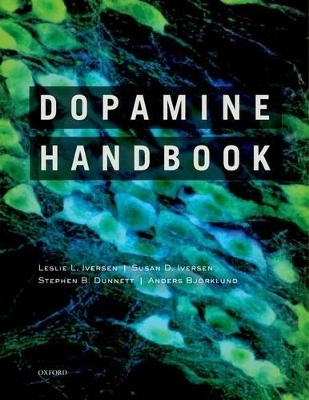
Dopamine Handbook
Oxford University Press Inc (Verlag)
978-0-19-537303-5 (ISBN)
The discovery of dopamine in 1957-1958 was one of the seminal events in the development of modern neuroscience, and has been extremely important for the development of modern therapies of neurological and psychiatric disorders. Dopamine has a fundamental role in almost all aspects of behavior: from motor control to mood regulation, cognition and addiction and reward, and dopamine research has been unique within the neurosciences in the way it has bridged basic science and clinical practice. Over the decades research into the role of dopamine in health and disease has been in the forefront of modern neuroscience. The Dopamine Handbook is the first single-volume publication to capture current progress and excitement in this dynamic research field.
Leslie L. Iversen, PhD, is Professor of Pharmacology at the University of Oxford, Oxford. Susan D. Iversen, PhD, is a Professor in the Department of Experimental Psychology at the University of Oxford, Oxford, UK Stephen B. Dunnett, PhD is a Professor in the School of Biosciences at Cardiff University, Cardiff, Wales, UK. Anders Björklund, MD, PhD, is a Professor at the Wallenberg Neuroscience Center Division of Neurobiology at Lund University in Lund, Sweden
Contributors
Chapter 1: Overview: A Personal View of the Dopamine Neuron in Historical Perspective
Floyd E. Bloom
Chapter 2: Neuroanatomy
2.1. Functional Neuroanatomy of Dopamine in the Striatum
Charles R. Gerfen
2.2. Functional Implications of Dopamine D2 Receptor Localization in Relation to Glutamate
Neurons
Susan R. Sesack
2.3. Convergence of Limbic, Cognitive and Motor Cortico-striatal Circuits with Dopamine Pathways in Primate
Brain
Suzanne N. Haber
2.4. The Relationship between Dopaminergic Axons and Glutamatergic Synapses in the Striatum: Structural
Considerations.
J. Paul Bolam and Jonathan Moss
Chapter 3: Molecular Pharmacology
3.1. Molecular Pharmacology of the Dopamine Receptors
David R. Sibley, Michele L. Rankin, Lisa A. Hazelwood, R. Benjamin Free, Yoon Namkung, Elizabeth B. Rex,
and Rebecca A. Roof
3.2. Role of Dopamine Transporters in Neuronal Homeostasis
Marc G. Caron and Raul R. Gainetdinov
3.3. Intracellular Dopamine Signaling
Gilberto Fisone
3.4. Ion Channels & Regulation of Neuronal Activity
Birgit Liss and Jochen Roeper
Chapter 4: Genes in Development
4.1.Genetic Control of Meso-diencephalic Dopaminergic Neuron Developments in Rodents
Wolfgang Wurst and Nilima Prakash
4.2. Factors Shaping Later Stages of Dopamine Neuron Development
Robert E. Burke
4.3. Postnatal Maturation of Dopamine Actions in the Prefrontal Cortex
Patricio O'Donnell and Kuei Y. Tseng
4.4. Genetic Dissection of Dopamine Mediated Prefrontal-Striatal Mechanisms and Its Relationship to
Schizophrenia
Daniel Weinberger and Hao-Yang Tan
Chapter 5: DA in Prefrontal Cortex and Cognition
5.1. From Behavior to Cognition: Functions of Mesostriatal, Mesolimbic and Mesocortical Dopamine Systems
Trevor W. Robbins
5.2. Contributions of Mesocorticolimbic Dopamine to Cognition and Executive Function
Stan B. Floresco
5.3. Dopamine's Influence on Prefrontal Cortical Cognition: Actions and Circuits of Behaving
Primates
Amy F.T. Arnsten, Susheel Vijayraghavan, Min Wang, Nao J. Gamo, and Constantinos D.
Paspalas
5.4. Dopaminergic Modulation of Flexible Cognitive Control in Humans
Mark D'Esposito and Roshan Cools
5.5. Neurocomputational analysis of DA Function
Daniel Durstewitz
Chapter 6: Ventral Striatum and Reward
6.1. Dopamine and Motor Function in Rat and Mouse Models of Parkinson's Disease
Timothy Schallert and Sheila M. Fleming
6.2. Involvement of Nucleus Accumbens Dopamine in Behavioral Activation and Effort-related
Functions
John D. Salamone
6.3. Functional Heterogeneity in Striatal Subregions and Neurotransmitter Systems: Implications
for Understanding the Neural Substrates Underlying Appetitive Motivation and Learning
Brian A. Baldo and Matthew E. Andrzejewski
6.4. Behavioral Functions of Dopamine Neurons
Philippe N. Tobler
Chapter 7: Plasticity of Forebrain DA Systems
7.1. Dynamic Templates for Neuroplasticity in the Striatum
Ann M. Graybiel
7.2. DA and Synaptic Plasticity in Mesolimbic Circuits
Robert C. Malenka, F. Woodward Hopf, and Antonello Bonci
7.3. Dopaminergic Modulation of Striatal Glutamatergic Signaling in Health and Parkinson's
Disease
D. James Surmeier, Michelle Day, Tracy Gertler, Savio Chan, and Weixing Shen
Chapter 8: DA Mechanisms in Addiction
8.1. The Role of Dopamine in the Motivational Vulnerability to Addiction
George F. Koob and Michel Le Moal
8.2. Dopaminergic Mechanisms in Drug Seeking Habits and the Vulnerability to Drug Addiction
Barry J. Everitt, David Belin, Jeffrey W. Dalley, and Trevor W. Robbins
8.3. Imaging Dopamine's Role in Drug Abuse and Addiction
Nora D. Volkow, Joanna S. Fowler, Gene-Jack Wang, Frank Telang, and Ruben Baler
Chapter 9: Parkinson's disease
9.1. Exploring the Myths about Parkinson's disease
Yves Agid and Andreas Hartmann
9.2. Pathophysiology of L-DOPA-induced Dyskinesia in Parkinson's disease
M. Angela Cenci
9.3. Progression of Parkinson's disease Revealed by Imaging Studies
David J. Brooks
9.4. Transplantation of Dopamine Neurons: Extent and Mechanisms of Functional Recovery in
Rodent Models of Parkinson's disease
Stephen B. Dunnett and Anders Björklund
9.5. Clinical Experiences with Dopamine Neuron Replacement in Parkinson's disease. What is
the Future?
Olle Lindvall
9.6. Novel Gene-based Therapeutics Targeting the Dopaminergic System in Parkinson's disease
Deniz Kirik, Jeffrey H. Kordower, Shilpa Ramaswamy, and Tomas Björklund
9.7. Neuroprotective Strategies in Parkinson's Disease
C. Warren Olanow
Chapter 10: Schizophrenia and Other Psychiatric Illnesses
10.1. Dopamine Dysfunction in Schizophrenia
Anissa Abi-Dargham, Mark Slifstein, Larry Kegeles, and Marc Laruelle
10.2. Neuropharmacological Profiles of Antipsychotic Drugs
Bryan L. Roth and Sarah C. Rogan
10.3. How Antipsychotics Work-Linking Receptors to Response
Shitij Kapur and Nathalie Ginovart
10.4. Dopamine Dysfunction in Schizophrenia: From Genetic Susceptibility to Cognitive Impairment
Andreas Meyer-Lindenberg, Heike Tost, and Shabnam Hakimi
10.5. The Role of Dopamine in the Pathophysiology and Treatment of Major Depressive Disorder
Charles B. Nemeroff and Boadie W. Dunlop
10.6. DA Modulation of Forebrain Pathways and the Pathophysiology of Psychiatric Disorders
Anthony A. Grace
Index
| Erscheint lt. Verlag | 30.11.2009 |
|---|---|
| Zusatzinfo | 188 halftones, Colour inserts-32pp colour plates |
| Verlagsort | New York |
| Sprache | englisch |
| Maße | 282 x 211 mm |
| Gewicht | 1792 g |
| Themenwelt | Medizin / Pharmazie ► Medizinische Fachgebiete ► Laboratoriumsmedizin |
| Medizin / Pharmazie ► Medizinische Fachgebiete ► Neurologie | |
| Medizin / Pharmazie ► Medizinische Fachgebiete ► Pharmakologie / Pharmakotherapie | |
| Naturwissenschaften ► Biologie ► Humanbiologie | |
| Naturwissenschaften ► Biologie ► Zoologie | |
| ISBN-10 | 0-19-537303-0 / 0195373030 |
| ISBN-13 | 978-0-19-537303-5 / 9780195373035 |
| Zustand | Neuware |
| Haben Sie eine Frage zum Produkt? |
aus dem Bereich


